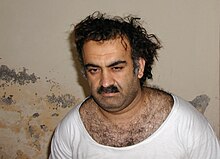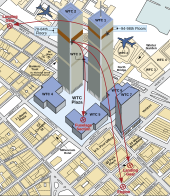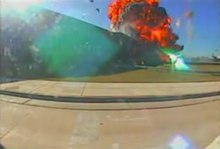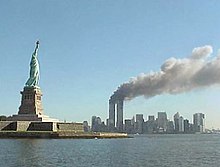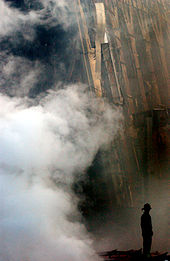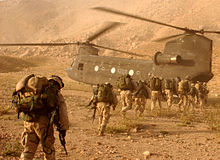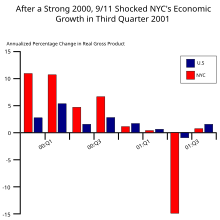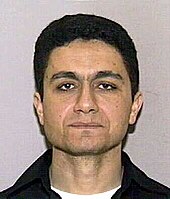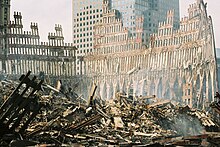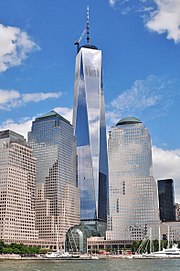| September 11 attacks | |
|---|---|
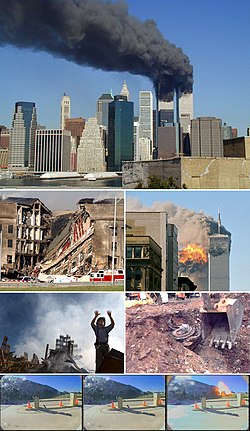
| |
| Location |
|
| Date | September 11, 2001 8:46 a.m. – 10:28 a.m. (EDT) |
| Target |
|
Attack type
|
|
| Deaths | 2,996 (2,977 victims + 19 hijackers) |
Non-fatal injuries
| 6,000+ |
| Perpetrators |
Al-Qaeda[1] (see also responsibility and hijackers)
|
No. of participants
| 19 |
The September 11 attacks (also referred to as 9/11) were a series of four coordinated terrorist attacks by the Islamic terrorist group al-Qaeda against the United States on the morning of Tuesday, September 11, 2001. The attacks killed 2,996 people, injured over 6,000 others, and caused at least $10 billion in infrastructure and property damage. Additional people died of 9/11-related cancer and respiratory diseases in the months and years following the attacks.
Four passenger airliners operated by two major U.S. passenger air carriers (United Airlines and American Airlines)—all of which departed from airports in the northeastern part of the United States bound for California—were hijacked by 19 al-Qaeda terrorists. Two of the planes, American Airlines Flight 11 and United Airlines Flight 175, were crashed into the North and South towers, respectively, of the World Trade Center complex in Lower Manhattan. Within an hour and 42 minutes, both 110-story towers collapsed. Debris and the resulting fires caused partial or complete collapse of all other buildings in the World Trade Center complex, including the 47-story 7 World Trade Center tower, as well as significant damage to ten other large surrounding structures. A third plane, American Airlines Flight 77, was crashed into the Pentagon (the headquarters of the United States Department of Defense) in Arlington County, Virginia, which led to a partial collapse of the building's west side. The fourth plane, United Airlines Flight 93, was initially flown toward Washington, D.C., but crashed into a field in Stonycreek Township near Shanksville, Pennsylvania, after its passengers thwarted the hijackers. 9/11 is the single deadliest incident for firefighters and law enforcement officers in the history of the United States, with 343 and 72 killed, respectively.
Suspicion quickly fell on al-Qaeda. The United States responded by launching the War on Terror and invaded Afghanistan to depose the Taliban, which had failed to comply with U.S. demands to extradite Osama bin Laden and expel al-Qaeda from Afghanistan. Many countries strengthened their anti-terrorism legislation and expanded the powers of law enforcement and intelligence agencies to prevent terrorist attacks. Although al-Qaeda's leader, Osama bin Laden, initially denied any involvement, in 2004 he claimed responsibility for the attacks.[1] Al-Qaeda and bin Laden cited U.S. support of Israel, the presence of U.S. troops in Saudi Arabia, and sanctions against Iraq as motives. After evading capture for almost a decade, Osama bin Laden was located and killed in Pakistan by SEAL Team Six of the U.S. Navy in May 2011.
The destruction of the World Trade Center and nearby infrastructure seriously harmed the economy of Lower Manhattan and had a significant effect on global markets, which resulted in the closing of Wall Street until September 17 and the civilian airspace in the U.S. and Canada until September 13. Many closings, evacuations, and cancellations followed, out of respect or fear of further attacks. Cleanup of the World Trade Center site was completed in May 2002, and the Pentagon was repaired within a year. On November 18, 2006, construction of One World Trade Center began at the World Trade Center site. The building was officially opened on November 3, 2014. Numerous memorials have been constructed, including the National September 11 Memorial & Museum in New York City, the Pentagon Memorial in Arlington County, Virginia, and the Flight 93 National Memorial in a field in Stonycreek Township near Shanksville, Pennsylvania.
Background
Al-Qaeda
In a second fatwā in 1998, bin Laden outlined his objections to American foreign policy with respect to Israel, as well as the continued presence of American troops in Saudi Arabia after the Gulf War. Bin Laden used Islamic texts to exhort Muslims to attack Americans until the stated grievances are reversed. Muslim legal scholars "have throughout Islamic history unanimously agreed that the jihad is an individual duty if the enemy destroys the Muslim countries", according to bin Laden.
Osama bin Laden
Osama bin Laden at about 40 years of age, 1997
Bin Laden orchestrated the attacks and initially denied involvement but later recanted his false statements. Al Jazeera broadcast a statement by bin Laden on September 16, 2001, stating, "I stress that I have not carried out this act, which appears to have been carried out by individuals with their own motivation." In November 2001, U.S. forces recovered a videotape from a destroyed house in Jalalabad, Afghanistan. In the video, bin Laden is seen talking to Khaled al-Harbi and admits foreknowledge of the attacks. On December 27, 2001, a second bin Laden video was released. In the video, he said:
It has become clear that the West in general and America in particular have an unspeakable hatred for Islam. ... It is the hatred of crusaders. Terrorism against America deserves to be praised because it was a response to injustice, aimed at forcing America to stop its support for Israel, which kills our people. ... We say that the end of the United States is imminent, whether Bin Laden or his followers are alive or dead, for the awakening of the Muslim umma (nation) has occurredbut he stopped short of admitting responsibility for the attacks. The transcript refers several times to the United States specifically targeting Muslims.
Shortly before the U.S. presidential election in 2004, bin Laden used a taped statement to publicly acknowledge al-Qaeda's involvement in the attacks on the United States. He admitted his direct link to the attacks and said they were carried out because:
we are free ... and want to regain freedom for our nation. As you undermine our security, we undermine yours.Bin Laden said he had personally directed his followers to attack the World Trade Center and the Pentagon. Another video obtained by Al Jazeera in September 2006 shows bin Laden with Ramzi bin al-Shibh, as well as two hijackers, Hamza al-Ghamdi and Wail al-Shehri, as they make preparations for the attacks. The U.S. never formally indicted bin Laden for the 9/11 attacks but he was on the FBI's Most Wanted List for the bombings of the U.S. Embassies in Dar es Salaam, Tanzania, and Nairobi, Kenya. After a 10-year manhunt, bin Laden was killed by American special forces in a compound in Abbottabad, Pakistan on May 2, 2011.
Khalid Sheikh Mohammed
Khalid Sheikh Mohammed after his capture in 2003
Journalist Yosri Fouda of the Arabic television channel Al Jazeera reported that, in April 2002, Khalid Sheikh Mohammed admitted his involvement, along with Ramzi bin al-Shibh. The 9/11 Commission Report determined that the animosity towards the United States felt by Mohammed, the principal architect of the 9/11 attacks, stemmed from his "violent disagreement with U.S. foreign policy favoring Israel". Mohammed was also an adviser and financier of the 1993 World Trade Center bombing and the uncle of Ramzi Yousef, the lead bomber in that attack.
Mohammed was arrested on March 1, 2003, in Rawalpindi, Pakistan, by Pakistani security officials working with the CIA. He was then held at multiple CIA secret prisons and Guantanamo Bay where he was interrogated and tortured with methods including waterboarding. During U.S. hearings at Guantanamo Bay in March 2007, Mohammed again confessed his responsibility for the attacks, stating he "was responsible for the 9/11 operation from A to Z" and that his statement was not made under duress.
Other al-Qaeda members
In "Substitution for Testimony of Khalid Sheikh Mohammed" from the trial of Zacarias Moussaoui, five people are identified as having been completely aware of the operation's details. They are bin Laden, Khalid Sheikh Mohammed, Ramzi bin al-Shibh, Abu Turab al-Urduni, and Mohammed Atef. To date, only peripheral figures have been tried or convicted for the attacks.On September 26, 2005, the Spanish high court sentenced Abu Dahdah to 27 years in prison for conspiracy on the 9/11 attacks and being a member of the terrorist organization al-Qaeda. At the same time, another 17 al-Qaeda members were sentenced to penalties of between six and eleven years. On February 16, 2006, the Spanish Supreme Court reduced the Abu Dahdah penalty to 12 years because it considered that his participation in the conspiracy was not proven.
Also in 2006, Moussaoui—who some originally suspected might have been the assigned 20th hijacker—was convicted for the lesser role of conspiracy to commit acts of terrorism and air piracy. He was sentenced to life without parole in the United States. Mounir el-Motassadeq, an associate of the Hamburg-based hijackers, is serving 15 years in Germany for his role in helping the hijackers prepare for the attacks.
The Hamburg cell in Germany included radical Islamists who eventually came to be key operatives in the 9/11 attacks. Mohamed Atta, Marwan al-Shehhi, Ziad Jarrah, Ramzi bin al-Shibh, and Said Bahaji were all members of al-Qaeda's Hamburg cell.
Motives
Osama bin Laden's declaration of a holy war against the United States, and a 1998 fatwā signed by bin Laden and others, calling for the killing of Americans, are seen by investigators as evidence of his motivation. In bin Laden's November 2002 "Letter to America", he explicitly stated that al-Qaeda's motives for their attacks include:- U.S. support of Israel
- support for the "attacks against Muslims" in Somalia
- support of Philippines against Muslims in the Moro conflict
- support for Israeli "aggression" against Muslims in Lebanon
- support of Russian "atrocities against Muslims" in Chechnya
- pro-American governments in the Middle East (who "act as your agents") being against Muslim interests
- support of Indian "oppression against Muslims" in Kashmir
- the presence of U.S. troops in Saudi Arabia
- the sanctions against Iraq
Bin Laden interpreted Muhammad as having banned the "permanent presence of infidels in Arabia". In 1996, bin Laden issued a fatwā calling for American troops to leave Saudi Arabia. In 1998, al-Qaeda wrote, "for over seven years the United States has been occupying the lands of Islam in the holiest of places, the Arabian Peninsula, plundering its riches, dictating to its rulers, humiliating its people, terrorizing its neighbors, and turning its bases in the Peninsula into a spearhead through which to fight the neighboring Muslim peoples."
In a December 1999 interview, bin Laden said he felt that Americans were "too near to Mecca", and considered this a provocation to the entire Muslim world.[49] One analysis of suicide terrorism suggested that without U.S. troops in Saudi Arabia, al-Qaeda likely would not have been able to get people to commit to suicide missions.
In the 1998 fatwā, al-Qaeda identified the Iraq sanctions as a reason to kill Americans, condemning the "protracted blockade" among other actions that constitute a declaration of war against "Allah, his messenger, and Muslims." The fatwā declared that "the ruling to kill the Americans and their allies – civilians and military – is an individual duty for every Muslim who can do it in any country in which it is possible to do it, in order to liberate the al-Aqsa Mosque and the holy mosque of Mecca from their grip, and in order for their [the Americans'] armies to move out of all the lands of Islam, defeated and unable to threaten any Muslim."
In 2004, Bin Laden claimed that the idea of destroying the towers had first occurred to him in 1982, when he witnessed Israel's bombardment of high-rise apartment buildings during the 1982 Lebanon War. Some analysts, including Mearsheimer and Walt, also claimed that U.S. support of Israel was one motive for the attacks. In 2004 and 2010, bin Laden again connected the September 11 attacks with U.S. support of Israel, although most of the letter expressed bin Laden's disdain for President Bush and bin Laden's hope to "destroy and bankrupt" the U.S.
Other motives have been suggested in addition to those stated by bin Laden and al-Qaeda, including western support of Islamic and non-Islamic authoritarian regimes in Saudi Arabia, Iran, Egypt, Iraq, Pakistan and northern Africa, and the presence of western troops in some of these countries. Some authors suggested the "humiliation" that resulted from the Islamic world falling behind the Western world – this discrepancy was rendered especially visible by the globalization trend and a desire to provoke the U.S. into a broader war against the Islamic world in the hope of motivating more allies to support al-Qaeda. Similarly, others have argued that 9/11 was a strategic move with the objective of provoking America into a war that would incite a pan-Islamic revolution.
Planning
Map showing the attacks on the World Trade Center (the planes are not drawn to scale)
The idea for the attacks came from Khalid Sheikh Mohammed, who first presented it to Osama bin Laden in 1996. At that time, bin Laden and al-Qaeda were in a period of transition, having just relocated back to Afghanistan from Sudan. The 1998 African Embassy bombings and bin Laden's 1998 fatwā marked a turning point, as bin Laden became intent on attacking the United States.
In late 1998 or early 1999, bin Laden gave approval for Mohammed to go forward with organizing the plot. A series of meetings occurred in early 1999, involving Mohammed, bin Laden, and his deputy Mohammed Atef. Atef provided operational support for the plot, including target selections and helping arrange travel for the hijackers. Bin Laden overruled Mohammed, rejecting some potential targets such as the U.S. Bank Tower in Los Angeles because "there was not enough time to prepare for such an operation".
Diagram showing the attacks on the World Trade Center
Bin Laden provided leadership and financial support for the plot, and was involved in selecting participants. Bin Laden initially selected Nawaf al-Hazmi and Khalid al-Mihdhar, both experienced jihadists who had fought in Bosnia. Hazmi and Mihdhar arrived in the United States in mid-January 2000. In spring 2000, Hazmi and Mihdhar took flying lessons in San Diego, California, but both spoke little English, performed poorly with flying lessons, and eventually served as secondary – or "muscle" – hijackers.
In late 1999, a group of men from Hamburg, Germany arrived in Afghanistan; the group included Mohamed Atta, Marwan al-Shehhi, Ziad Jarrah, and Ramzi bin al-Shibh. Bin Laden selected these men because they were educated, could speak English, and had experience living in the West. New recruits were routinely screened for special skills and al-Qaeda leaders consequently discovered that Hani Hanjour already had a commercial pilot's license. Mohammed later said that he helped the hijackers blend in by teaching them how to order food in restaurants and dress in Western clothing.
Hanjour arrived in San Diego on December 8, 2000, joining Hazmi. They soon left for Arizona, where Hanjour took refresher training. Marwan al-Shehhi arrived at the end of May 2000, while Atta arrived on June 3, 2000, and Jarrah arrived on June 27, 2000. Bin al-Shibh applied several times for a visa to the United States, but as a Yemeni, he was rejected out of concerns he would overstay his visa and remain as an illegal immigrant. Bin al-Shibh stayed in Hamburg, providing coordination between Atta and Mohammed. The three Hamburg cell members all took pilot training in South Florida.
In spring of 2001, the secondary hijackers began arriving in the United States. In July 2001, Atta met with bin al-Shibh in Spain, where they coordinated details of the plot, including final target selection. Bin al-Shibh also passed along bin Laden's wish for the attacks to be carried out as soon as possible. Some of the hijackers received passports from corrupt Saudi officials who were family members, or used fraudulent passports to gain entry.
Prior intelligence
In late 1999, al-Qaeda associate Walid bin Attash ("Khallad") contacted Mihdhar, telling him to meet him in Kuala Lumpur, Malaysia; Hazmi and Abu Bara al Yemeni would also be in attendance. The NSA intercepted a telephone call mentioning the meeting, Mihdhar, and the name "Nawaf" (Hazmi). While the agency feared that "Something nefarious might be afoot", it took no further action. The CIA had already been alerted by Saudi intelligence to the status of Mihdhar and Hazmi as al-Qaeda members, and a CIA team broke into Mihdhar's Dubai hotel room and discovered that Mihdhar had a U.S. visa. While Alec Station alerted intelligence agencies worldwide about this fact, it did not share this information with the FBI. The Malaysian Special Branch observed the January 5, 2000, meeting of the two al-Qaeda members, and informed the CIA that Mihdhar, Hazmi, and Khallad were flying to Bangkok, but the CIA never notified other agencies of this, nor did it ask the State Department to put Mihdhar on its watchlist. An FBI liaison to Alec Station asked permission to inform the FBI of the meeting, but was told that "'This is not a matter for the FBI.'"By late June, senior counter-terrorism official Richard Clarke and CIA director George Tenet were "convinced that a major series of attacks was about to come", although the CIA believed that the attacks would likely occur in Saudi Arabia or Israel. In early July, Clarke put domestic agencies on "full alert", telling them that "Something really spectacular is going to happen here ... soon." He asked the FBI and the State Department to alert the embassies and police departments, and the Defense Department to go to "Threat Condition Delta." Clarke would later write that "Somewhere in CIA there was information that two known al Qaeda terrorists had come into the United States. ... in [the] FBI there was information that strange things had been going on at flight schools in the United States. ... They had specific information about individual terrorists. ... None of that information got to me or the White House."
On July 13, Tom Wilshire, a CIA agent assigned to the FBI's international terrorism division, emailed his superiors at the CIA's Counterterrorism Center (CTC), requesting permission to inform the FBI that Hazmi was in the country and that Mihdhar had a U.S. visa. The CIA never responded.
The same day in July, Margarette Gillespie, an FBI analyst working in the CTC, was told to review material about the Malaysia meeting. She was not told of the participants' presence in the U.S. The CIA gave Gillespie surveillance photos of Mihdhar and Hazmi from the meeting to show to FBI counterterrorism, but did not tell her their significance. The Intelink database informed her not to share intelligence material on the meeting to criminal investigators. When shown the photos, the FBI were refused more details on their significance, and also did not receive Mihdhar's date of birth or passport number. In late August 2001, Gillespie told the INS, the State Department, the Customs Service, and the FBI to put Hazmi and Mihdhar on their watchlists, but the FBI was prohibited from using criminal agents in the search for the duo, which hindered their efforts.
Also in July, a Phoenix-based FBI agent sent a message to FBI headquarters, Alec Station, and to FBI agents in New York, alerting them to "the possibility of a coordinated effort by Osama bin Laden to send students to the United States to attend civil aviation universities and colleges." The agent, Kenneth Williams, suggested the need to interview all flight school managers and identify all Arab students seeking flight training. In July, Jordan alerted the U.S. that al-Qaeda was planning an attack on the U.S.; "months later", Jordan notified the U.S. that the attack's codename was "The Big Wedding", and that it involved airplanes.
On August 6, the CIA's Presidential Daily Brief, designated "For the President Only", was entitled "Bin Ladin Determined to Strike in U.S." The memo noted that "The FBI information ... indicates patterns of suspicious activity in this country consistent with preparations for hijackings or other types of attacks."
In mid-August, one Minnesota flight school alerted the FBI to Zacarias Moussaoui, who had asked "suspicious questions." The FBI found that he was a radical who had traveled to Pakistan, and the INS arrested him for overstaying his French visa. Their request to search his laptop was denied by FBI headquarters due to the lack of probable cause.
The failures in intelligence-sharing were attributed to 1995 Justice Department policies limiting intelligence sharing, combined with CIA and NSA reluctance in revealing "sensitive sources and methods" such as tapped phones. Testifying before the 9/11 Commission in April 2004, then-Attorney General John Ashcroft recalled that the "single greatest structural cause for the September 11th problem was the wall that segregated or separated criminal investigators and intelligence agents."[89] Clarke also wrote that "There were failures in the organizations ... failures to get information to the right place at the right time."
Attacks
Flight paths of the four planes used on September 11
Early on the morning of September 11, 2001, 19 hijackers took control of four commercial airliners (two Boeing 757 and two Boeing 767) en route to California (three headed to LAX in Los Angeles and one to SFO in San Francisco) after takeoffs from Logan International Airport in Boston, Massachusetts; Newark Liberty International Airport in Newark, New Jersey; and Washington Dulles International Airport in Loudoun and Fairfax counties in Virginia. Large planes with long flights were selected for hijacking because they would be heavily fueled.
The four flights were:
- American Airlines Flight 11: a Boeing 767 aircraft, departed Logan Airport at 7:59 a.m. en route to Los Angeles with a crew of 11 and 76 passengers, not including five hijackers. The hijackers flew the plane into the northern facade of the North Tower of the World Trade Center in New York City at 8:46 a.m.
- United Airlines Flight 175: a Boeing 767 aircraft, departed Logan Airport at 8:14 a.m. en route to Los Angeles with a crew of nine and 51 passengers, not including five hijackers. The hijackers flew the plane into the southern facade of the South Tower of the World Trade Center in New York City at 9:03 a.m.
- American Airlines Flight 77: a Boeing 757 aircraft, departed Washington Dulles International Airport at 8:20 a.m. en route to Los Angeles with a crew of six and 53 passengers, not including five hijackers. The hijackers flew the plane into the western facade of the Pentagon in Arlington County, Virginia, at 9:37 a.m.
- United Airlines Flight 93: a Boeing 757 aircraft, departed Newark International Airport at 8:42 am en route to San Francisco, with a crew of seven and 33 passengers, not including four hijackers. As passengers attempted to subdue the hijackers, the aircraft crashed into a field in Stonycreek Township near Shanksville, Pennsylvania, at 10:03 a.m.
The four crashes
The attacks seen from space by NASA
Collapse of the towers as seen from across the Hudson River in New Jersey
The north face of Two World Trade Center (south tower) immediately after being struck by United Airlines Flight 175
Three buildings in the World Trade Center collapsed due to fire-induced structural failure. The South Tower collapsed at 9:59 a.m. after burning for 56 minutes in a fire caused by the impact of United Airlines Flight 175 and the explosion of its fuel. The North Tower collapsed at 10:28 a.m. after burning for 102 minutes. When the North Tower collapsed, debris fell on the nearby 7 World Trade Center building (7 WTC), damaging it and starting fires. These fires burned for hours, compromising the building's structural integrity, and 7 WTC collapsed at 5:21 pm. The west side of the Pentagon sustained significant damage.
Security camera footage of American Airlines Flight 77 hitting the Pentagon. The plane hits the Pentagon approximately 86 seconds after the start of this recording.
At 9:42 am, the Federal Aviation Administration (FAA) grounded all civilian aircraft within the continental U.S., and civilian aircraft already in flight were told to land immediately. All international civilian aircraft were either turned back or redirected to airports in Canada or Mexico, and were banned from landing on United States territory for three days. The attacks created widespread confusion among news organizations and air traffic controllers. Among the unconfirmed and often contradictory news reports aired throughout the day, one of the most prevalent said a car bomb had been detonated at the U.S. State Department's headquarters in Washington, D.C. Another jet—Delta Air Lines Flight 1989—was suspected of having been hijacked, but the aircraft responded to controllers and landed safely in Cleveland, Ohio.
In an April 2002 interview, Khalid Sheikh Mohammed and Ramzi bin al-Shibh, who are believed to have organized the attacks, said Flight 93's intended target was the United States Capitol, not the White House. During the planning stage of the attacks, Mohamed Atta, the hijacker and pilot of Flight 11, thought the White House might be too tough a target and sought an assessment from Hani Hanjour (who hijacked and piloted Flight 77). Mohammed said al-Qaeda initially planned to target nuclear installations rather than the World Trade Center and the Pentagon, but decided against it, fearing things could "get out of control". Final decisions on targets, according to Mohammed, were left in the hands of the pilots.
Casualties
A surviving portion of the wall from the Twin Towers
In Arlington County, Virginia, 125 Pentagon workers lost their lives when Flight 77 crashed into the western side of the building. Of these, 70 were civilians and 55 were military personnel, many of them who worked for the United States Army or the United States Navy. The Army lost 47 civilian employees, six civilian contractors, and 22 soldiers, while the Navy lost six civilian employees, three civilian contractors, and 33 sailors. Seven Defense Intelligence Agency (DIA) civilian employees were also among the dead in the attack, as well as an Office of the Secretary of Defense (OSD) contractor. Lieutenant General Timothy Maude, an Army Deputy Chief of Staff, was the highest-ranking military official killed at the Pentagon.
The Statue of Liberty with the towers burning in the background
In New York City, more than 90% of the workers and visitors who died in the towers had been at or above the points of impact. In the North Tower, 1,355 people at or above the point of impact were trapped and died of smoke inhalation, fell or jumped from the tower to escape the smoke and flames, or were killed in the building's eventual collapse. The destruction of all three staircases in the tower when Flight 11 hit made it impossible for anyone above the impact zone to escape. 107 people below the point of impact died as well.
In the South Tower, one stairwell, Stairwell A, was left intact after Flight 175 hit, allowing 14 people located on the floors of impact (including one man who saw the plane coming at him) and four more from the floors above to escape. New York City 9-1-1 operators who received calls from individuals inside the tower were not well informed of the situation as it rapidly unfolded and as a result, told callers not to descend the tower on their own. In total 630 people died in that tower, fewer than half the number killed in the North Tower. Casualties in the South Tower were significantly reduced by some occupants deciding to start evacuating as soon as the North Tower was struck. The failure to fully evacuate the South Tower after the first jet crash into the North Tower was described by USA Today as "one of the day's great tragedies".
An Urban Search and Rescue Task Force German shepherd dog works to uncover victims at the site of the World Trade Center after the attacks.
Cantor Fitzgerald L.P., an investment bank on the 101st–105th floors of the North Tower, lost 658 employees, considerably more than any other employer. Marsh Inc., located immediately below Cantor Fitzgerald on floors 93–100, lost 358 employees, and 175 employees of Aon Corporation were also killed. The National Institute of Standards and Technology (NIST) estimated that about 17,400 civilians were in the World Trade Center complex at the time of the attacks. Turnstile counts from the Port Authority suggest 14,154 people were typically in the Twin Towers by 8:45 am. Most people below the impact zone safely evacuated the buildings.
Weeks after the attack, the death toll was estimated to be over 6,000, more than twice the number of deaths eventually confirmed. The city was only able to identify remains for about 1,600 of the World Trade Center victims. The medical examiner's office collected "about 10,000 unidentified bone and tissue fragments that cannot be matched to the list of the dead". Bone fragments were still being found in 2006 by workers who were preparing to demolish the damaged Deutsche Bank Building. In 2010, a team of anthropologists and archaeologists searched for human remains and personal items at the Fresh Kills Landfill, where 72 more human remains were recovered, bringing the total found to 1,845. DNA profiling continues in an attempt to identify additional victims. The remains are being held in storage in Memorial Park, outside the New York City Medical Examiner's facilities. It was expected that the remains would be moved in 2013 to a repository behind a wall at the 9/11 museum. In July 2011, a team of scientists at the Office of Chief Medical Examiner was still trying to identify remains, in the hope that improved technology will allow them to identify other victims. On August 7, 2017, the 1,641st victim was identified as a result of newly available DNA technology, and a 1,642nd on July 26, 2018. Further 1,111 victims are yet to be identified.
Damage
World Trade Center site (Ground Zero) with an overlay showing the original building locations
The Pentagon was damaged by fire and partly collapsed.
The Deutsche Bank Building across Liberty Street from the World Trade Center complex was later condemned as uninhabitable because of toxic conditions inside the office tower, and was deconstructed. The Borough of Manhattan Community College's Fiterman Hall at 30 West Broadway was condemned due to extensive damage in the attacks, and is being rebuilt. Other neighboring buildings (including 90 West Street and the Verizon Building) suffered major damage but have been restored. World Financial Center buildings, One Liberty Plaza, the Millenium Hilton, and 90 Church Street had moderate damage and have since been restored. Communications equipment on top of the North Tower was also destroyed, with only WCBS-TV maintaining a backup transmitter on the Empire State Building, but media stations were quickly able to reroute the signals and resume their broadcasts.
The PATH train system's World Trade Center station was located under the complex. As a result, the entire station was demolished completely when the towers collapsed, and the tunnels leading to Exchange Place station in Jersey City, New Jersey were flooded with water. The Cortlandt Street station on the New York City Subway's IRT Broadway-Seventh Avenue Line was also within close proximity to the World Trade Center complex, and the entire station, along with the surrounding track, was reduced to rubble. The latter station remains closed, but is due to reopen in December 2018, barring any significant delays.
The Pentagon was severely damaged by the impact of American Airlines Flight 77 and ensuing fires, causing one section of the building to collapse. As the airplane approached the Pentagon, its wings knocked down light poles and its right engine hit a power generator before crashing into the western side of the building. The plane hit the Pentagon at the first-floor level. The front part of the fuselage disintegrated on impact, while the mid and tail sections kept moving for another fraction of a second. Debris from the tail section penetrated furthest into the building, breaking through 310 feet (94 m) of the three outermost of the building's five rings.
Rescue efforts
EMS workers rescue and evacuate an injured victim of the Pentagon attack.
After the first tower collapsed, FDNY commanders issued evacuation warnings. Due to technical difficulties with malfunctioning radio repeater systems, many firefighters never heard the evacuation orders. 9-1-1 dispatchers also received information from callers that was not passed along to commanders on the scene. Within hours of the attack, a substantial search, and rescue operation was launched. After months of around-the-clock operations, the World Trade Center site was cleared by the end of May 2002.
Aftermath
President George W. Bush is briefed on the attacks.
Immediate response
Eight hours after the attacks, Donald Rumsfeld, then U.S. Secretary of Defense, declares "The Pentagon is functioning."
For the first time in U.S. history, SCATANA was invoked, thus stranding tens of thousands of passengers across the world. The FAA closed American airspace to all international flights, causing about five hundred flights to be turned back or redirected to other countries. Canada received 226 of the diverted flights and launched Operation Yellow Ribbon to deal with the large numbers of grounded planes and stranded passengers.
The 9/11 attacks had immediate effects on the American people. Police and rescue workers from around the country took a leave of absence from their jobs and traveled to New York City to help recover bodies from the twisted remnants of the Twin Towers. Blood donations across the U.S. surged in the weeks after 9/11.
The deaths of adults in the attacks resulted in over 3,000 children losing a parent. Subsequent studies documented children's reactions to these actual losses and to feared losses of life, the protective environment in the aftermath of the attacks, and effects on surviving caregivers.
Domestic reactions
Following the attacks, President George W. Bush's approval rating soared to 90%. On September 20, 2001, he addressed the nation and a joint session of the United States Congress regarding the events of September 11 and the subsequent nine days of rescue and recovery efforts, and described his intended response to the attacks. New York City mayor Rudy Giuliani's highly visible role won him high praise in New York and nationally.
Many relief funds were immediately set up to assist victims of the attacks, with the task of providing financial assistance to the survivors of the attacks and to the families of victims. By the deadline for victim's compensation on September 11, 2003, 2,833 applications had been received from the families of those who were killed.
Contingency plans for the continuity of government and the evacuation of leaders were implemented soon after the attacks. Congress was not told that the United States had been under a continuity of government status until February 2002.
In the largest restructuring of the U.S. government in contemporary history, the United States enacted the Homeland Security Act of 2002, creating the Department of Homeland Security. Congress also passed the USA PATRIOT Act, saying it would help detect and prosecute terrorism and other crimes. Civil liberties groups have criticized the PATRIOT Act, saying it allows law enforcement to invade the privacy of citizens and that it eliminates judicial oversight of law enforcement and domestic intelligence. In an effort to effectively combat future acts of terrorism, the National Security Agency (NSA) was given broad powers. NSA commenced warrantless surveillance of telecommunications, which was sometimes criticized since it permitted the agency "to eavesdrop on telephone and e-mail communications between the United States and people overseas without a warrant". In response to requests by various intelligence agencies, the United States Foreign Intelligence Surveillance Court permitted an expansion of powers by the U.S. government in seeking, obtaining, and sharing information on U.S. citizens as well as non-U.S. people from around the world.
Hate crimes
A fireman looks up at the remains of the South Tower.
A fireman can be seen in silhouette at the base of the rubble.
According to an academic study, people perceived to be Middle Eastern were as likely to be victims of hate crimes as followers of Islam during this time. The study also found a similar increase in hate crimes against people who may have been perceived as Muslims, Arabs, and others thought to be of Middle Eastern origin. A report by the South Asian American advocacy group known as South Asian Americans Leading Together, documented media coverage of 645 bias incidents against Americans of South Asian or Middle Eastern descent between September 11 and 17. Various crimes such as vandalism, arson, assault, shootings, harassment, and threats in numerous places were documented.
Muslim American response
Muslim organizations in the United States were swift to condemn the attacks and called "upon Muslim Americans to come forward with their skills and resources to help alleviate the sufferings of the affected people and their families". These organizations included the Islamic Society of North America, American Muslim Alliance, American Muslim Council, Council on American-Islamic Relations, Islamic Circle of North America, and the Shari'a Scholars Association of North America. Along with monetary donations, many Islamic organizations launched blood drives and provided medical assistance, food, and shelter for victims.International reactions
The attacks were denounced by mass media and governments worldwide. Across the globe, nations offered pro-American support and solidarity. Leaders in most Middle Eastern countries, and Afghanistan, condemned the attacks. Iraq was a notable exception, with an immediate official statement that, "the American cowboys are reaping the fruit of their crimes against humanity". The government of Saudi Arabia officially condemned the attacks, but privately many Saudis favored bin Laden's cause. Although Palestinian Authority (PA) president Yasser Arafat also condemned the attacks, there were reports of celebrations in the West Bank, Gaza Strip, and East Jerusalem—with a celebration involving 3,000 Palestinians dancing in the streets and handing out candy being filmed in Nablus despite alleged PA warnings that it could not guarantee the safety of journalists attempting to document the event. Similar demonstrations took place in Amman, Jordan, where there is a large population of Palestinian descent. As in the United States, the aftermath of the attacks saw tensions increase in other countries between Muslims and non-Muslims.United Nations Security Council Resolution 1368 condemned the attacks, and expressed readiness to take all necessary steps to respond and combat all forms of terrorism in accordance with their Charter. Numerous countries introduced anti-terrorism legislation and froze bank accounts they suspected of al-Qaeda ties. Law enforcement and intelligence agencies in a number of countries arrested alleged terrorists.
British Prime Minister Tony Blair said Britain stood "shoulder to shoulder" with the United States. A few days later, Blair flew to Washington to affirm British solidarity with the United States. In a speech to Congress, nine days after the attacks, which Blair attended as a guest, President Bush declared "America has no truer friend than Great Britain." Subsequently, Prime Minister Blair embarked on two months of diplomacy to rally international support for military action; he held 54 meetings with world leaders and travelled more than 40,000 miles (60,000 km).
Vladimir Putin (right) and his wife attend a commemoration service for the victims of the terrorist attacks, November 16, 2001
The U.S. set up the Guantanamo Bay detention camp to hold inmates they defined as "illegal enemy combatants". The legitimacy of these detentions has been questioned by the European Union and human rights organizations.
On September 25, 2001, Iran's fifth president, Mohammad Khatami meeting British Foreign Secretary, Jack Straw, said: "Iran fully understands the feelings of the Americans about the terrorist attacks in New York and Washington on September 11." He said although the American administrations had been at best indifferent about terrorist operations in Iran (since 1979), the Iranians instead felt differently and had expressed their sympathetic feelings with bereaved Americans in the tragic incidents in the two cities. He also stated that "Nations should not be punished in place of terrorists." According to Radio Farda's website, when the attacks' news was released, some Iranian citizens gathered in front of the Embassy of Switzerland in Tehran, which serves as the protecting power of the United States in Iran (U.S. interests protecting office in Iran), to express their sympathy and some of them lit candles as a symbol of mourning. This piece of news at Radio Farda's website also states that in 2011, on the anniversary of the attacks, United States Department of State, published a post at its blog, in which the Department thanked Iranian people for their sympathy and stated that they would never forget Iranian people's kindness on those harsh days. After the attacks, both the President and the Supreme Leader of Iran, condemned the attacks. The BBC and Time magazine published reports on holding candlelit vigils for the victims by Iranian citizens at their websites. According to Politico Magazine, following the attacks, Sayyed Ali Khamenei, the Supreme Leader of Iran, "suspended the usual 'Death to America' chants at Friday prayers" temporarily.
In a speech by the Nizari Ismaili Imam at the Nobel Institute in 2005, Aga Khan IV stated that the "9/11 attack on the United States was a direct consequence of the international community ignoring the human tragedy that was Afghanistan at that time".
In September 2001, shortly after the attacks, Greek soccer fans burned an Israeli flag and unsuccessfully tried to burn an American flag. Though the American flag did not catch fire, the fans booed during a moment of silence for victims of the attacks.
Military operations
At 2:40 p.m. in the afternoon of September 11, Secretary of Defense Donald Rumsfeld was issuing rapid orders to his aides to look for evidence of Iraqi involvement. According to notes taken by senior policy official Stephen Cambone, Rumsfeld asked for, "Best info fast. Judge whether good enough hit S.H." (Saddam Hussein) "at same time. Not only UBL" (Osama bin Laden). Cambone's notes quoted Rumsfeld as saying, "Need to move swiftly – Near term target needs – go massive – sweep it all up. Things related and not." In a meeting at Camp David on September 15 the Bush administration rejected the idea of attacking Iraq in response to 9/11. Nonetheless, they later invaded the country with allies, citing "Saddam Hussein's support for terrorism". At the time, as many as 7 in 10 Americans believed the Iraqi president played a role in the 9/11 attacks. Three years later, Bush conceded that he had not.The NATO council declared that the terrorist attacks on the United States were an attack on all NATO nations that satisfied Article 5 of the NATO charter. This marked the first invocation of Article 5, which had been written during the Cold War with an attack by the Soviet Union in mind. Australian Prime Minister John Howard who was in Washington D.C. during the attacks invoked Article IV of the ANZUS treaty. The Bush administration announced a War on Terror, with the stated goals of bringing bin Laden and al-Qaeda to justice and preventing the emergence of other terrorist networks. These goals would be accomplished by imposing economic and military sanctions against states harboring terrorists, and increasing global surveillance and intelligence sharing.
On September 14, 2001, the U.S. Congress passed the Authorization for Use of Military Force Against Terrorists. Still in effect, it grants the President the authority to use all "necessary and appropriate force" against those whom he determined "planned, authorized, committed or aided" the September 11 attacks, or who harbored said persons or groups.
On October 7, 2001, the War in Afghanistan began when U.S. and British forces initiated aerial bombing campaigns targeting Taliban and al-Qaeda camps, then later invaded Afghanistan with ground troops of the Special Forces. This eventually led to the overthrow of the Taliban rule of Afghanistan with the Fall of Kandahar on December 7, 2001, by U.S.-led coalition forces. Conflict in Afghanistan between the Taliban insurgency and the Afghan forces backed by NATO Resolute Support Mission is ongoing. The Philippines and Indonesia, among other nations with their own internal conflicts with Islamic terrorism, also increased their military readiness.
The military forces of the United States of America and the Islamic Republic of Iran cooperated with each other to overthrow the Taliban regime which had had conflicts with the government of Iran. Iran's Quds Force helped U.S. forces and Afghan rebels in the 2001 uprising in Herat.
Effects
Health issues
Two survivors are covered in dust after the collapse of the towers.
Hundreds of thousands of tons of toxic debris containing more than 2,500 contaminants, including known carcinogens, were spread across Lower Manhattan due to the collapse of the Twin Towers. Exposure to the toxins in the debris is alleged to have contributed to fatal or debilitating illnesses among people who were at Ground Zero. The Bush administration ordered the Environmental Protection Agency (EPA) to issue reassuring statements regarding air quality in the aftermath of the attacks, citing national security, but the EPA did not determine that air quality had returned to pre-September 11 levels until June 2002.
Health effects extended to residents, students, and office workers of Lower Manhattan and nearby Chinatown. Several deaths have been linked to the toxic dust, and the victims' names were included in the World Trade Center memorial. Approximately 18,000 people have been estimated to have developed illnesses as a result of the toxic dust. There is also scientific speculation that exposure to various toxic products in the air may have negative effects on fetal development. A notable children's environmental health center is currently analyzing the children whose mothers were pregnant during the WTC collapse, and were living or working nearby. A study of rescue workers released in April 2010 found that all those studied had impaired lung functions, and that 30–40% were reporting little or no improvement in persistent symptoms that started within the first year of the attack.
Years after the attacks, legal disputes over the costs of illnesses related to the attacks were still in the court system. On October 17, 2006, a federal judge rejected New York City's refusal to pay for health costs for rescue workers, allowing for the possibility of numerous suits against the city. Government officials have been faulted for urging the public to return to lower Manhattan in the weeks shortly after the attacks. Christine Todd Whitman, administrator of the EPA in the aftermath of the attacks, was heavily criticized by a U.S. District Judge for incorrectly saying that the area was environmentally safe. Mayor Giuliani was criticized for urging financial industry personnel to return quickly to the greater Wall Street area.
On December 22, 2010, the United States Congress passed the James L. Zadroga 9/11 Health and Compensation Act, which President Barack Obama signed into law on January 2, 2011. It allocated $4.2 billion to create the World Trade Center Health Program, which provides testing and treatment for people suffering from long-term health problems related to the 9/11 attacks. The WTC Health Program replaced preexisting 9/11-related health programs such as the Medical Monitoring and Treatment Program and the WTC Environmental Health Center program.
Economic
The
table shows that the 9/11 attacks had a major effect on the economy of
New York City (in red), compared to the United States' economy overall
(in blue).
In New York City, about 430,000 job-months and $2.8 billion dollars in wages were lost in the first three months after the attacks. The economic effects were mainly on the economy's export sectors. The city's GDP was estimated to have declined by $27.3 billion for the last three months of 2001 and all of 2002. The U.S. government provided $11.2 billion in immediate assistance to the Government of New York City in September 2001, and $10.5 billion in early 2002 for economic development and infrastructure needs.
Also hurt were small businesses in Lower Manhattan near the World Trade Center, 18,000 of which were destroyed or displaced, resulting in lost jobs and their consequent wages. Assistance was provided by Small Business Administration loans, federal government Community Development Block Grants, and Economic Injury Disaster Loans. Some 31,900,000 square feet (2,960,000 m2) of Lower Manhattan office space was damaged or destroyed. Many wondered whether these jobs would return, and if the damaged tax base would recover. Studies of the economic effects of 9/11 show the Manhattan office real-estate market and office employment were less affected than first feared, because of the financial services industry's need for face-to-face interaction.
North American air space was closed for several days after the attacks and air travel decreased upon its reopening, leading to a nearly 20% cutback in air travel capacity, and exacerbating financial problems in the struggling U.S. airline industry.
The September 11 attacks also led to the U.S. wars in Afghanistan and Iraq, as well as additional homeland security spending, totaling at least $5 trillion.
Cultural influence
The impact of 9/11 extends beyond geopolitics into society and culture in general. Immediate responses to 9/11 included greater focus on home life and time spent with family, higher church attendance, and increased expressions of patriotism such as the flying of flags. The radio industry responded by removing certain songs from playlists, and the attacks have subsequently been used as background, narrative or thematic elements in film, television, music and literature. Already-running television shows as well as programs developed after 9/11 have reflected post-9/11 cultural concerns. 9/11 conspiracy theories have become social phenomena, despite lack of support from expert scientists, engineers, and historians. 9/11 has also had a major impact on the religious faith of many individuals; for some it strengthened, to find consolation to cope with the loss of loved ones and overcome their grief; others started to question their faith or lost it entirely, because they could not reconcile it with their view of religion.The culture of America succeeding the attacks is noted for heightened security and an increased demand thereof, as well as paranoia and anxiety regarding future terrorist attacks that includes most of the nation. Psychologists have also confirmed that there has been an increased amount of national anxiety in commercial air travel.
Government policies toward terrorism
As a result of the attacks, many governments across the world passed legislation to combat terrorism. In Germany, where several of the 9/11 terrorists had resided and taken advantage of that country's liberal asylum policies, two major anti-terrorism packages were enacted. The first removed legal loopholes that permitted terrorists to live and raise money in Germany. The second addressed the effectiveness and communication of intelligence and law enforcement. Canada passed the Canadian Anti-Terrorism Act, that nation's first anti-terrorism law. The United Kingdom passed the Anti-terrorism, Crime and Security Act 2001 and the Prevention of Terrorism Act 2005. New Zealand enacted the Terrorism Suppression Act 2002.In the United States, the Department of Homeland Security was created by the Homeland Security Act to coordinate domestic anti-terrorism efforts. The USA Patriot Act gave the federal government greater powers, including the authority to detain foreign terror suspects for a week without charge, to monitor telephone communications, e-mail, and Internet use by terror suspects, and to prosecute suspected terrorists without time restrictions. The FAA ordered that airplane cockpits be reinforced to prevent terrorists gaining control of planes, and assigned sky marshals to flights. Further, the Aviation and Transportation Security Act made the federal government, rather than airports, responsible for airport security. The law created the Transportation Security Administration to inspect passengers and luggage, causing long delays and concern over passenger privacy.[308] After suspected abuses of the USA Patriot Act were brought to light in June 2013 with articles about collection of American call records by the NSA and the PRISM program (see 2013 mass surveillance disclosures), Representative Jim Sensenbrenner, Republican of Wisconsin, who introduced the Patriot Act in 2001, said that the National Security Agency overstepped its bounds.
Investigations
FBI
Immediately after the attacks, the Federal Bureau of Investigation started PENTTBOM, the largest criminal inquiry in the history of the United States. At its height, more than half of the FBI's agents worked on the investigation and followed a half-million leads. The FBI concluded that there was "clear and irrefutable" evidence linking al-Qaeda and bin Laden to the attacks.
Mohamed Atta, an Egyptian national, was the ringleader of the hijackers.
The FBI was quickly able to identify the hijackers, including leader Mohamed Atta, when his luggage was discovered at Boston's Logan Airport. Atta had been forced to check two of his three bags due to space limitations on the 19-seat commuter flight he took to Boston. Due to a new policy instituted to prevent flight delays, the luggage failed to make it aboard American Airlines Flight 11 as planned. The luggage contained the hijackers' names, assignments, and al-Qaeda connections. "It had all these Arab-language (sic) papers that amounted to the Rosetta stone of the investigation", said one FBI agent. Within hours of the attacks, the FBI released the names and in many cases the personal details of the suspected pilots and hijackers. On September 27, 2001, they released photos of all 19 hijackers, along with information about possible nationalities and aliases. Fifteen of the men were from Saudi Arabia, two from the United Arab Emirates, one from Egypt, and one from Lebanon.
By midday, the U.S. National Security Agency and German intelligence agencies had intercepted communications pointing to Osama bin Laden. Two of the hijackers were known to have travelled with a bin Laden associate to Malaysia in 2000 and hijacker Mohammed Atta had previously gone to Afghanistan. He and others were part of a terrorist cell in Hamburg. One of the members of the Hamburg cell was discovered to have been in communication with Khalid Sheik Mohammed who was identified as a member of al-Qaeda.
Authorities in the United States and Britain also obtained electronic intercepts, including telephone conversations and electronic bank transfers, which indicate that Mohammed Atef, a bin Laden deputy, was a key figure in the planning of the 9/11 attacks. Intercepts were also obtained that revealed conversations that took place days before September 11 between bin Laden and an associate in Pakistan. In those conversations, the two referred to "an incident that would take place in America on, or around, September 11" and they discussed potential repercussions. In another conversation with an associate in Afghanistan, bin Laden discussed the "scale and effects of a forthcoming operation." These conversations did not specifically mention the World Trade Center or Pentagon, or other specifics.
| Nationality | Number |
|---|---|
| Saudi Arabia |
15
|
| United Arab Emirates |
2
|
| Egypt |
1
|
| Lebanon |
1
|
CIA
The Inspector General of the Central Intelligence Agency (CIA) conducted an internal review of the agency's pre-9/11 performance and was harshly critical of senior CIA officials for not doing everything possible to confront terrorism. He criticized their failure to stop two of the 9/11 hijackers, Nawaf al-Hazmi and Khalid al-Mihdhar, as they entered the United States and their failure to share information on the two men with the FBI. In May 2007, senators from both major U.S. political parties drafted legislation to make the review public. One of the backers, Senator Ron Wyden said, "The American people have a right to know what the Central Intelligence Agency was doing in those critical months before 9/11."Congressional inquiry
In February 2002, the Senate Select Committee on Intelligence and the House Permanent Select Committee on Intelligence formed a joint inquiry into the performance of the U.S. Intelligence Community. Their 832-page report released in December 2002 detailed failings of the FBI and CIA to use available information, including about terrorists the CIA knew were in the United States, in order to disrupt the plots. The joint inquiry developed its information about possible involvement of Saudi Arabian government officials from non-classified sources. Nevertheless, the Bush administration demanded 28 related pages remain classified. In December 2002, the inquiry's chair Bob Graham (D-FL) revealed in an interview that there was "evidence that there were foreign governments involved in facilitating the activities of at least some of the terrorists in the United States." September 11 victim families were frustrated by the unanswered questions and redacted material from the Congressional inquiry and demanded an independent commission. September 11 victim families, members of congress and the Saudi Arabian government are still seeking release of the documents. In June 2016, CIA chief John Brennan says that he believes 28 redacted pages of a congressional inquiry into 9/11 will soon be made public, and that they will prove that the government of Saudi Arabia had no involvement in the September 11 attacks.In September 2016, the Congress passed the Justice Against Sponsors of Terrorism Act that would allow relatives of victims of the September 11 attacks to sue Saudi Arabia for its government's alleged role in the attacks.
9/11 Commission
The National Commission on Terrorist Attacks Upon the United States (9/11 Commission), chaired by Thomas Kean and Lee H. Hamilton, was formed in late 2002 to prepare a thorough account of the circumstances surrounding the attacks, including preparedness for and the immediate response to the attacks. On July 22, 2004, the Commission issued the 9/11 Commission Report. The report detailed the events of 9/11, found the attacks were carried out by members of al-Qaeda, and examined how security and intelligence agencies were inadequately coordinated to prevent the attacks. Formed from an independent bipartisan group of mostly former Senators, Representatives, and Governors, the commissioners explained, "We believe the 9/11 attacks revealed four kinds of failures: in imagination, policy, capabilities, and management". The Commission made numerous recommendations on how to prevent future attacks, and in 2011 was dismayed that several of its recommendations had yet to be implemented.National Institute of Standards and Technology
The exterior support columns from the lower level of the South Tower remain standing after the collapse of the building.
NIST found that the fireproofing on the Twin Towers' steel infrastructures was blown off by the initial impact of the planes and that, had this not occurred, the towers likely would have remained standing. A 2007 study of the north tower's collapse published by researchers of Purdue University determined that, since the plane's impact had stripped off much of the structure's thermal insulation, the heat from a typical office fire would have softened and weakened the exposed girders and columns enough to initiate the collapse regardless of the number of columns cut or damaged by the impact.
The director of the original investigation stated that "the towers really did amazingly well. The terrorist aircraft didn't bring the buildings down; it was the fire which followed. It was proven that you could take out two-thirds of the columns in a tower and the building would still stand." The fires weakened the trusses supporting the floors, making the floors sag. The sagging floors pulled on the exterior steel columns causing the exterior columns to bow inward. With the damage to the core columns, the buckling exterior columns could no longer support the buildings, causing them to collapse. Additionally, the report found the towers' stairwells were not adequately reinforced to provide adequate emergency escape for people above the impact zones. NIST concluded that uncontrolled fires in 7 WTC caused floor beams and girders to heat and subsequently "caused a critical support column to fail, initiating a fire-induced progressive collapse that brought the building down".
Rebuilding
Rebuilt One World Trade Center nearing completion in July 2013
The damaged section of the Pentagon was rebuilt and occupied within a year of the attacks. The temporary World Trade Center PATH station opened in late 2003 and construction of the new 7 World Trade Center was completed in 2006. Work on rebuilding the main World Trade Center site was delayed until late 2006 when leaseholder Larry Silverstein and the Port Authority of New York and New Jersey agreed on financing. The construction of One World Trade Center began on April 27, 2006, and reached its full height on May 20, 2013. The spire was installed atop the building at that date, putting 1 WTC's height at 1,776 feet (541 m) and thus claiming the title of the tallest building in the Western Hemisphere. One WTC finished construction and opened on November 3, 2014.
On the World Trade Center site, three more office towers are expected to be built one block east of where the original towers stood. Construction has begun on all three of these towers.
Memorials
The Tribute in Light on September 11, 2014, on the thirteenth anniversary of the attacks, seen from Bayonne, New Jersey. The tallest building in the picture is the new One World Trade Center.
One of the first memorials was the Tribute in Light, an installation of 88 searchlights at the footprints of the World Trade Center towers. In New York City, the World Trade Center Site Memorial Competition was held to design an appropriate memorial on the site. The winning design, Reflecting Absence, was selected in August 2006, and consists of a pair of reflecting pools in the footprints of the towers, surrounded by a list of the victims' names in an underground memorial space.[359] The memorial was completed on September 11, 2011; a museum also opened on site on May 21, 2014.
In Arlington County, The Pentagon Memorial was completed and opened to the public on the seventh anniversary of the attacks in 2008. It consists of a landscaped park with 184 benches facing the Pentagon. When the Pentagon was repaired in 2001–2002, a private chapel and indoor memorial were included, located at the spot where Flight 77 crashed into the building.
In Shanksville, a concrete and glass visitor center was opened on September 10, 2015, situated on a hill overlooking the crash site and the white marble Wall of Names. An observation platform at the visitor center and the white marble wall are both aligned beneath the path of Flight 93. A temporary memorial is located 500 yards (457 m) from the crash site. New York City firefighters donated a cross made of steel from the World Trade Center and mounted on top of a platform shaped like the Pentagon. It was installed outside the firehouse on August 25, 2008. Many other permanent memorials are elsewhere. Scholarships and charities have been established by the victims' families, and by many other organizations and private figures.
On every anniversary, in New York City, the names of the victims who died there are read out against a background of somber music. The President of the United States attends a memorial service at the Pentagon, and asks Americans to observe Patriot Day with a moment of silence. Smaller services are held in Shanksville, Pennsylvania, which are usually attended by the President's spouse.

